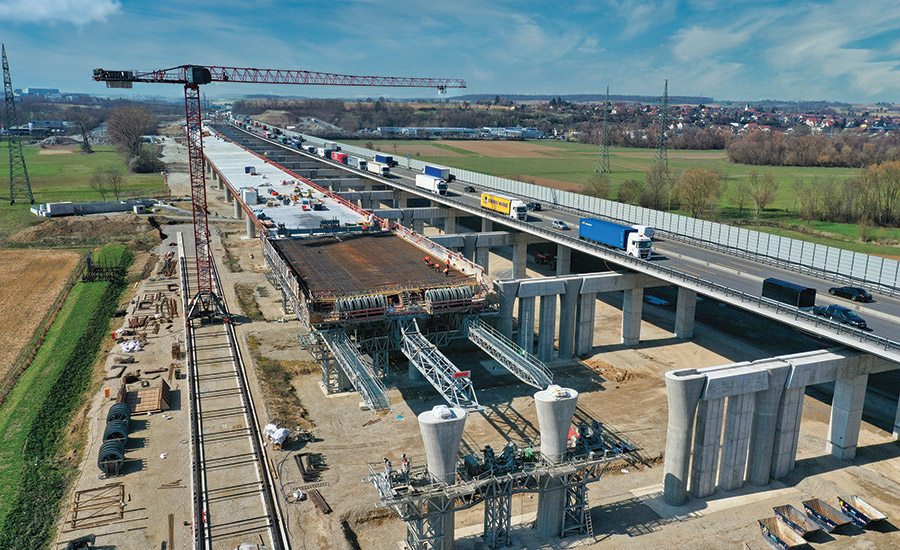International contractors on the long road to rebounding from the COVID-19 pandemic might find a shortcut to recovery in infrastructure projects, as countries ramp up spending to help build economies back to normal. While the global construction market is red hot for some firms, it is stone cold for others as contractors deal with unpredictable project risks while readying for new growth opportunities.
To say that the pandemic has “disrupted life and commerce globally is stating the obvious,” says S. N. Subrahmanyan, managing director and CEO of Larsen & Toubro Ltd. But revenue numbers and insights from this year’s Top 250 International Contractors add a new perspective to the global conversation on how to drive economic recovery.
Total international contracting revenue for the Top 250 dropped 11.1% to $420.4 billion in 2020, from $473.1 billion in 2019. This decrease also marks the largest single-year drop recorded in ENR international contracting data going back to 2003.
Not much has changed for firms ranked in the Top 25 positions—save for the return of Fluor, which had no survey filed last year; Saipem SpA, which had not filed since 2017; and Exyte GmbH, which enters the rankings for the first time at No. 22. The top seven ranked companies are in the exact same positions they held last year. But even the highest ranking international firms could not escape undergoing major internal changes to cope with COVID-19 disruptions and keep projects and profits moving.
Related Links
ENR 2021 Top 250 Global Contractors
ENR’s 2021 Top 250 International Contractors
View complete 2021 list, with full market analysis
(Subscription Required)
In No. 24-ranked Bechtel’s case, the company has turned the pandemic’s impact into international innovation. Because of COVID-19, “we have probably taken a five-year leap ahead,” reports Shaun Kenny, president of its global infrastructure business. The company now also uses technology “much better,” he says. “The pandemic has accelerated the adoption of remote working not just in offices but also for inspections of workshops and sites.”
Eighteen months into the COVID-19 outbreak, many international contracting firms are now finding their footing by taking steps to make their operations more flexible. Contractors report consolidating staff abroad, utilizing more digital technologies to manage projects and diversifying logistic partners to help ensure availability of materials. And while emergency actions to move managing projects online have proved successful, for many firms “it’s still unproven that we can build new teams,” in new markets digitally, says Kenny.
Mitigating Pandemic Risk
229
of the Top 250 sent in surveys last year
Under rapidly changing market conditions and client priorities, Top 250 contractors say they are shoring up global operations to better manage risks, reap the rewards of new projects and rethink organizational structures to make them more resistant to pandemics.
At Larsen & Toubro, “The crisis has taught us the importance of agility, interdependence and trust,” explains Subrahmanyan. Over more than two decades, the company has built a robust presence in countries belonging to the Gulf Cooperation Council. With COVID-19 limiting in-person travel, the company leaned on digital technologies to reach across borders and solve challenges.
“Construction jobs and contracts are always risky, and the profit rewards do not always reflect that,” says Subrahmanyan. “Although we are an India-centric company, we are now executing projects across almost all infrastructure domains.”
36.7%
increased international revenue in 2020
In addition to a cultural shift in technology usage, Ant Yapi, which currently operates in four countries, also reports a shift in business models for its sector.
“The COVID-19 pandemic has impacted the whole world, and every single aspect of our lives, from the way we do business to our personal relationships,” says Mehmet Okay, a member of Ant Yapi’s executive board. “During this time, which we call the new normal, we believe differentiation stands out, and this is our biggest advantage,” he says. “There will always be challenges in the business world, so we think that the most important thing is to be able to take the right steps at the right time.”
Timing has become a major determinant in keeping project material costs down during periods of high demand. As Subrahmanyan of Larsen & Toubro explains it, large exchange rate changes and the rising price of raw materials are part and parcel for international construction projects. But the COVID-19 pandemic has amplified these factors to unpredictable levels for many contractors.
52.8%
increased domestic revenue in 2020
The current surge in materials costs is partly caused by the scarcity of supply, says Thomas Birtel, CEO of Austria-based Strabag SE. Even a small increase can have a big impact. A one cent rise in the cost of diesel amounts to $1 million added to Strabag’s annual fuel bill, he explains. While shortages will likely be temporary, costs will remain high as “demand is strong everywhere,” he says.
Afcons’ operations in countries such as Bhutan and Bangladesh and in various Africa and Middle East locations were impacted by the pandemic last year to varying degrees, explains managing director S. Paramasivan. Although some economies are opening up and countries are slowly lifting restrictions, he finds that the proliferation of new infrastructure projects on the horizon will still face many challenges.
“Over past few months, logistics cost has substantially increased, which is adversely impacting the cost of raw material transportation at our international projects,” says Paramasivan. “These bottlenecks have increased procurement lead time and added cost for key materials and equipment, putting pressure on our project timelines.”
Also, as countries continue to impose varied levels of restrictions on the movement of people and quarantine rules change, skilled worker deployment to international sites could also be impacted.
“As the world is bracing for more COVID-19 waves, it becomes imperative for us to look beyond our existing network to strengthen our supply chains,” says Paramasivan. “This includes finding more partners for material sourcing, as well as global vendors and logistic partners, which can help us in ensuring availability of key resources for our international operations.”
With uncertainties around COVID-19 seemingly here to stay despite vaccination efforts, contractors must factor in “new realistic lead times of supply of raw materials and equipment,” he says.
Beyond rising material costs, there are examples of where COVID-19 has caused a devaluation of currencies in regions, reports Guillermo Lorenzo, CEO of Comsa Corporación’s Infrastructure and Engineering services.
“COVID has been a serious difficulty and challenge to continue with our work abroad, mainly due to the restrictions implemented in various countries as a result of the pandemic,” says Lorenzo. “Our supplies have been delayed and become more expensive, and the effort made has had to be much greater to successfully meet our commitments.”
For Çalik Enerj CEO Onur Yücekal, one thing is clear: “COVID-19 has affected the way of doing business and changed the world order,” he says.
Of 229 contracting firms that filed surveys both last year and this year, ENR reports that 145 had less international revenue on this year’s list.
Lessons Learned
Because international contractors operate in various regions, some firms like Drees & Sommer SE were able to apply early lessons learned in one region to prevent mistakes in another. Based in Stuttgart, Germany, it had more lead time to respond to COVID-19 than most firms because of its 30 person-plus operation in Shanghai, China.
“I can’t say we preempted the crisis, but we were well prepared in terms of our digital infrastructure, and our workforce could seamlessly transition into working from anywhere, including the home office,” Steffen Szeidl, a Drees & Sommer executive board member, explains. “The onset of the COVID-19 crisis changed the needs and priorities of our clients.”
The firm had the opportunity to consult and learn from the experience of its colleagues in Shanghai who faced lockdowns two months before Europe and the rest of the world.
“Our global pool of industry experts developed new business models that helped the industry get back on its feet during the restart phase,” says Szeidl. Then the company tailored these new solutions according to the needs of its other 46 operations across Europe and Asia.
“The pandemic brought us face to face with issues such as digitization and sustainability that the construction sector would have had to address sooner or later anyway,” Szeidl points out. “2020 provided us with the opportunity to get a head start on implementing them. We took the crisis as the catalyst for change to demonstrate our ecological and social responsibilities.”
During the first half of 2021, Italy’s Webuild S.p.A. “achieved markedly positive results despite the persistence of global uncertainties linked to the pandemic,” says CEO Pietro Salini. “After a year of disruption in efficiencies, slowdowns and site closures, we can now have a more positive view.”
For Strabag, 2020 was a “paradox” when profits rose, generating a “very strong margin,” while sales slipped. Birtel expects this year’s output to improve but not match the record 2019 sales levels.
During the pandemic last year, Strabag’s output was 6% lower than in 2019, largely because of lockdowns in Chile and Singapore, which, with the Middle East, account for around 7% of group sales, he says. Sites in Europe remained open except for those in Austria, which had a month-long lockdown.
Because of COVID-19, the construction industry’s cyclical markets “are becoming more and more unpredictable,” says Pierre Anjolras, chairman of France-based Vinci Construction S.A. But “we know how to adjust to fluctuations.”
Vinci’s results in this year’s first half “confirm that we can win contracts despite the COVID crisis and that we can also deliver works,” says Anjolras. At mid-year, “we are pleased to have reached and exceeded our revenue levels, with 27% growth compared to the first half of 2020 and 7% growth compared to first-half 2019,” he adds.

“With growing sales and order books in all divisions above pre-pandemic levels, Hochtief can look to the future with great confidence.”
—Marcelino Fernández Verdes, CEO, Hochtief
The figures for the first time include the group’s highways unit Eurovia, which was merged with Vinci Construction earlier this year, creating a business with 115,000 employees and $27 billion in sales in 2020. The construction order book of $41 billion “gives us a certain amount of peace of mind amid the lingering uncertainty surrounding the pandemic and … puts us in a position to remain selective,” says Anjolras.
Median Top 250 contracting revenue on this year’s list is down to $413.4 million from $501.4 million, a 17.6% drop. However, domestic revenue rose 9.2%. Three firms accounting for a total of $20 billion in revenue on the 2020 list did not file this year. However, the return of Fluor and Saipem to the Top 100 and other firms new to the list added more than $17 billion.
The reported Top 250 backlog was more stable. This year, 91 firms listed increased backlog, 75 decreased and 41 stayed the same. Last year those numbers were 91, 64 and 48 respectively.
“With growing sales and order books in all divisions above pre-pandemic levels, Hochtief can look to the future with great confidence,” says Marcelino Fernández Verdes, CEO of Germany’s Hochtief A.G. Its half- year sales dipped 2% below the previous year to $12.2 billion, but recovered in the second quarter by 6% above last year.
Spain’s Acciona S.A. last month reported profits returning to pre-pandemic levels across the group. Construction sales also grew by 25% to $1.9 billion and accounted for nearly 75% of the company’s infrastructure output.
When it comes to staffing international operations, more firms decreased the number of employees (41.7%) than either increased (35.6%) or kept them the same (22.7%). On last year’s list, only 19% of firms decreased their international staffs. However, most are still hiring domestically, with 42.1% reporting an increase, 33.3% a decrease and 24.5% that they stayed the same. U.S.-based firms were more likely to increase their international staffs (42.3%) than those based in other regions (34.3%).
Economic stimulus investments in infrastructure should help ensure a “long-term boom,” says Strabag’s Birtel. While bank interest rates remain low, he expects private sector investment to continue, especially in residential and office building. Bechtel’s Kenny adds that “entities in the private sector and in the energy and connectivity space have kept going.”
Changing Climate
When asked which regions represent the greatest potential for project opportunities, Top 250 contractors reported a mixed bag, including the U.S., Africa, Asia, Australia and Europe. The common thread among all is potential investment in infrastructure projects and the continued urbanization boom.
“The urbanization trend will speed up at a remarkable rate in years to come, and projections show that by 2050 we could add another 2.5 billion people to the urban population,” says Søren Brøndum, managing director for buildings at Ramboll. This implies major climate challenges, “since the buildings industry accounts for 40% of global carbon emissions, of which 28% is operational carbon and 11% is embodied carbon,” he says.

“The urbanization trend will speed up at a remarkable rate in years to come.”
—Søren Brøndum, Managing Director, Ramboll
Vinci’s Anjolras is convinced “that need for new green infrastructure is huge and that these projects will fuel very important public and private investment plans.” The energy, environmental and digital transformation is accelerating, “and the COVID-19 crisis has reinforced this awareness in society,” he adds.
National policies to build back better “will be influencing our way of building in the future far more than in the past,” says Strabag’s Birtel. While he says the products of construction have become more sustainable, “our production methods lag far behind.” Strabag aims to make its in-house activities climate neutral by 2025 and the same for all operations by 2040, Birtel says.
Aiming for net-zero carbon is “gaining real traction,” says Bechtel’s Kenny. Infrastructure, one of Bechtel’s four business lines, now accounts for around one-third of group sales, and will become more engrossed in renewable energy, mobility and connectivity developments, he adds. Kenny cites the company’s recent partnership with Nautilus Data Technologies Inc. to build data centers that require 70% less power for cooling. Nautilus’ patented technology uses naturally cold large natural water bodies as heat sinks.
In the Middle East, “people are in a hurry to evolve away from oil-based economies and have kept going,” says Kenny.
The Saudi Arabian company NEOM Co. a year ago recruited Bechtel to manage the creation of futuristic utilities and a transportation system for a visionary zero-carbon city. Running for 170 km east from near the mouth of the Gulf of Aqaba, the city would comprise a string of car free, self-contained city spaces where everything needed would be no more than a short walk away. The project “is a very exciting proposition for us,” says Kenny.
For Strabag, however, prospects in the Middle East are “not that clear,” says Birtel, although the firm is committed to work in Oman.
One of the strongest deciding factors of success for any international contractor is a willingness to understand and conduct business on local terms, according to Turkey-based contractor Feka.
“We firstly try to understand the culture of the country we will work in. Another important issue is to conduct business in foreign countries where the business is flexible enough to work within the local laws and legislations,” says Feka general manager Akin Erden. “Prior to making a decision to [work] in foreign countries, we review the legal commitments to identify hazards that may prevent us from doing business.”
Availability and accessibility of resources and materials within the country is very critical for decision-making, according to Erden, especially when factoring in potential disruptions from COVID-19.
Highways
Expressway Expansion

Photo by Michael Endres, Viagwest, courtesy of Hochtief
As part of the ViA6West consortium, Hochtief (No. 2) is contractor for the six-lane expansion of federal highway A6 in southern Germany, which will include 36 bridges and noise barriers along the route.
Moving Markets Forward
For Italy-based contractor ICM SpA, the pandemic “severely impacted our operations in Italy and abroad,” says Giovanni Dolcetta, the company’s vice president and business development manager. However, its business strategy largely remained unaffected, he notes. ICM SpA saw its international acquisitions significantly grow in 2020 and in early 2021.
“After the first shocking period [of the pandemic], we returned to work almost at full speed, and the 2020 turnover is almost equal to the 2019 turnover, which is a great achievement attained with great efforts,” says Dolcetta.
But “the majority of project tenders have come to a halt and have led to little contracting by construction companies,” he notes. “The problem stems from the strong impact of COVID-19 on bids for future projects.”
Moving markets forward in the years ahead requires countries to recover the growth indicators that were present prior to the onset of the pandemic, explains Manuel Olivares, managing director of FCC Construcción America.
Olivares emphasizes the “importance of the different investment plans by the governments of different areas to recover jobs, projects and private investments, and return to a positive economic growth rate,” he says.
“We are hopeful in the development of infrastructure plans as a sector for the recovery of employment and the economy,” Olivares adds.






-Tideway-Aurecon_ENRready.jpg?height=200&t=1627594016&width=200)

Post a comment to this article
Report Abusive Comment